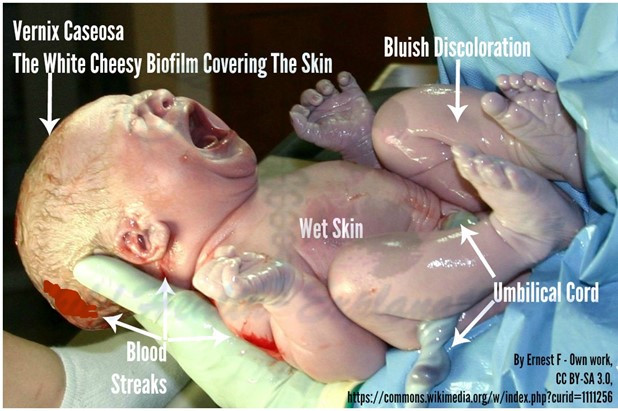The cheese-like, whitish substance that fuses with the epidermis and serves as a protective coating is called:
Vernix caseosa
Surfactant
Caput succedaneum
Acrocyanosis
The Correct Answer is A
Vernix caseosa is a cheese-like, whitish substance that fuses with the epidermis and serves as a protective coating for the newborn.

Some possible explanations for the other choices are:
- Choice B. Surfactant is a protein that lines the alveoli of the infant’s lungs and helps prevent them from collapsing.
- Choice C. Caput succedaneum is a swelling of the tissue over the presenting part of the fetal head caused by pressure during delivery.
- Choice D. Acrocyanosis is a bluish discoloration of the hands and feet due to reduced peripheral circulation.
Normal ranges for vernix caseosa are not applicable as it varies depending on the gestational age and skin maturity of the newborn. However, it is usually more abundant in preterm infants than in term or post-term infants.
Nursing Test Bank
Naxlex Comprehensive Predictor Exams
Related Questions
Correct Answer is D
Explanation
This test measures the amount of chloride in the sweat, which is abnormally high in people with cystic fibrosis (CF). CF is an inherited disorder that affects the cells that produce mucus, sweat, and digestive juices.

Choice A is wrong because bronchoscopy is a procedure that allows the doctor to examine the airways and lungs, but it is not essential for diagnosing CF.
Choice B is wrong because serum calcium is a blood test that measures the level of calcium in the blood, which is not related to CF.
Choice C is wrong because urine creatinine is a test that measures the amount of creatinine in the urine, which reflects the kidney function, but it is not relevant to CF.
Normal ranges for sweat chloride test are:
- Less than 40 millimoles per liter (mmol/L) for children and adults
- Less than 30 mmol/L for infants younger than 6 months
A sweat chloride level of more than 60 mmol/L is considered positive for CF.
Correct Answer is D
Explanation
Digoxin is a medication that helps improve the pumping function of the heart and reduces fluid retention in the lungs and other tissues. It is commonly used to treat congestive heart failure in infants.
Choice A is wrong because weighing the infant every day on the same scale at the same time is a way to monitor fluid balance, not an intervention to treat excess fluid volume.
Choice B is wrong because notifying the physician when weight gain exceeds more than 20 g/day is also a monitoring measure, not an intervention. Moreover, weight gain may not accurately reflect fluid volume status in some patients with heart failure due to poor nutrition and decreased appetite.
Choice C is wrong because putting the infant in a car seat to minimize movement may worsen the respiratory distress and increase the workload of the heart. The infant should be positioned in a semi-Fowler’s or Fowler’s position to facilitate breathing and reduce venous return.
Whether you are a student looking to ace your exams or a practicing nurse seeking to enhance your expertise , our nursing education contents will empower you with the confidence and competence to make a difference in the lives of patients and become a respected leader in the healthcare field.
Visit Naxlex, invest in your future and unlock endless possibilities with our unparalleled nursing education contents today
Report Wrong Answer on the Current Question
Do you disagree with the answer? If yes, what is your expected answer? Explain.
Kindly be descriptive with the issue you are facing.
